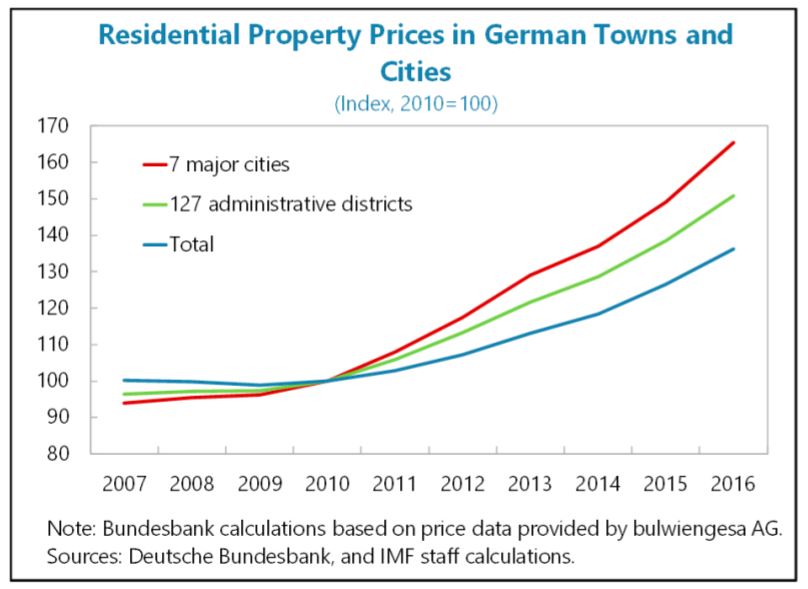Friday, July 6, 2018
Bank Competition, Risk Taking, and their Consequences: Evidence from the U.S. Mortgage and Labor Markets
From a new IMF working paper:
“The risk shifting incentive identified by Jensen and Meckling (1976) can induce excessive
risk taking by banks in a competitive environment (Hellmann, Murdock, and Stiglitz (2000)).
This paper tests this risk shifting hypothesis of competition in the U.S. mortgage market
between 2000 and 2005. Our study exploits a natural exogenous variation of local house
price volatility in the cross section of U.S. cities and counties, one of the most important
sources of risk for mortgage returns. This paper finds that banks in high-competition markets
lowered their lending standards (e.g., raising the loan-to-income ratio and acceptance rate) in anticipation of high house price volatility while those in low-competition markets did not, an indication consistent with the risk shifting hypothesis.This paper also examines the real economic consequences of this risk taking pattern through
the credit supply channel. In particular, it studies the change in local employment in
non-financail sectors at the beginning of the Great Recession. We find that between 2007 and
2009 non-financial sector employment in high competition markets lost 1.5 percent for one
standard deviation increase in local house price volatility, while this relationship was
insignificant for low-competition markets. This exercise identifies a credit-supply channel, in
addition to the demand channel shown in Mian and Sufi (2014), that contributed to the rise in non-financial sector unemployment during the Great Recession.The analysis in this study shows the importance of banks’ risk taking incentive due to
competition prior to the recent crisis. It helps deepen the understanding of why the financial
sector had accumulated so much mortgage risk despite that an reverting house price would
lead to massive mortgage defaults (e.g., Palmer (2015)). When studying the impact on the
real economy such as non-financial sector employment, this risk taking pattern can also be
used to identify the credit supply channel of bank lending. This analysis offers a possible
strategy to disentangle the supply and demand effects of bank lending on real economic
activities.”
From a new IMF working paper:
“The risk shifting incentive identified by Jensen and Meckling (1976) can induce excessive
risk taking by banks in a competitive environment (Hellmann, Murdock, and Stiglitz (2000)).
This paper tests this risk shifting hypothesis of competition in the U.S. mortgage market
between 2000 and 2005. Our study exploits a natural exogenous variation of local house
price volatility in the cross section of U.S.
Posted by at 5:04 PM
Labels: Global Housing Watch
Housing View – July 6, 2018
On cross-country:
- Global cities record weakest [house] price growth since 2015 – Knight Frank
- Top employers are helping with city housing – Raconteur
- Airbnb’s newest weapon against regulation: The Real Estate Industry – Wired
On the US:
- Are Affordability Perceptions Reducing Household Mobility and Exacerbating the Housing Shortage? – Fannie Mae
- Why does cost of living vary so much? Housing, housing, housing – Federal Reserve Bank of St. Louis
- Why is it so difficult to live where you work? Housing costs and homeownership in economic centers – Federal Reserve Bank of St. Louis
- What Will It Cost to Fix New York’s Public Housing? – New York Times
- San Francisco Is So Expensive, You Can Make Six Figures and Still Be ‘Low Income’ – New York Times
On other countries:
- [Australia] The Outlook for the Housing Market – Reserve Bank of Australia
- [Canada] Pricey Vancouver Housing Market Weakens With Buyers on Sidelines – Bloomberg
- [Germany] Berlin Aims to Cut Its Residential Real-Estate Boom Down to Size – Wall Street Journal
- [Hong Kong] Don’t Expect Hong Kong’s Vacant-Home Tax to Cool Prices – Bloomberg
- [Ireland] Irish lenders told to raise capital buffers – Financial Times
- [Singapore] Singapore Property Curbs Are a Mallet, Not a Hammer – Bloomberg
- [Spain] Housing In Spain: An Unbalanced Market, But Not A Bubble – The Corner
- [United Kingdom] Policy Exchange: housing speech – UK.Gov
- [United Kingdom] UK housing market stuck in doldrums as prices stagnate – Financial Times
Photo by Aliis Sinisalu
On cross-country:
- Global cities record weakest [house] price growth since 2015 – Knight Frank
- Top employers are helping with city housing – Raconteur
- Airbnb’s newest weapon against regulation: The Real Estate Industry – Wired
On the US:
- Are Affordability Perceptions Reducing Household Mobility and Exacerbating the Housing Shortage? – Fannie Mae
- Why does cost of living vary so much?
Posted by at 4:56 PM
Labels: Global Housing Watch
Thursday, July 5, 2018
House Prices in Mongolia
The IMF’s latest report on Mongolia says that:
“(…) …and housing prices stabilized after years of deflation, in line with stronger economic activity and household lending.”
The IMF’s latest report on Mongolia says that:
“(…) …and housing prices stabilized after years of deflation, in line with stronger economic activity and household lending.”
Posted by at 4:07 PM
Labels: Global Housing Watch
Optimal inflation and the identification of the Phillips curve
From a new VOX post by Michael McLeay and Silvana Tenreyro:
“We have long known that the empirical Phillips curve may vary with monetary policy (Lucas 1976). One common explanation for the Great Inflation of the 1970s is that policymakers mistakenly tried to exploit the prevailing reduced-form Phillips curve, and in so doing caused it to disappear (e.g. Sargent et al. 2006). In contrast, our point is that a disappearing Phillips curve is also a natural consequence of good monetary policy. If the true model of the economy involves a Phillips curve relationship, monetary policymakers aware of its existence should ensure it remains elusive in the data.”
From a new VOX post by Michael McLeay and Silvana Tenreyro:
“We have long known that the empirical Phillips curve may vary with monetary policy (Lucas 1976). One common explanation for the Great Inflation of the 1970s is that policymakers mistakenly tried to exploit the prevailing reduced-form Phillips curve, and in so doing caused it to disappear (e.g. Sargent et al. 2006). In contrast, our point is that a disappearing Phillips curve is also a natural consequence of good monetary policy.
Posted by at 1:13 PM
Labels: Macro Demystified
Germany’s Housing Market: Preventing Financial Excesses
The IMF’s latest report on Germany says that:
“Staff analysis suggests that house prices have risen faster than can be explained by demand and supply fundamentals in Germany’s major cities. House prices are rising moderately at the aggregate level, but have increased at double-digit rates in some hot spots where they
appear overvalued. Housing demand is driven by rising household income, large immigration flows in recent years, and low interest rates (…). On the supply side, stringent zoning restrictions (including for environmental protection) and high and rising capacity utilization (including labor shortages) in the construction sector prevent a more agile response of supply to price developments. House prices are most overvalued in Munich, Hamburg, Hannover, and Frankfurt, and are estimated to be more than 20 percent above their fundament level on average in major German cities (…). The Bundesbank obtains similar overvaluation estimates for some German cities in its latest assessment. As recommended in the past, lowering the effective burden of tax on new construction and reexamining zoning restrictions, in particular where demand is not likely to abate, would help mitigate price pressures.New housing policies, aimed at improving affordability, are not expected to have a
noticeable impact on prices. The government foresees spending €2 billion in renewed support for social housing in 2020–21, expanding the land available at a discount for social housing construction, and creating tax incentives to build on unused land. It also plans to allocate €2 billion to families with children acquiring a first home. Other measures are still being contemplated, including tax subsidies for rental housing, public loan guarantees and real estate tax exemptions to reduce equity requirements for owner-occupied houses, and strengthening rent controls. As these measures have counteracting effects on housing supply and demand, the overall impact on housing prices is likely to be small.Mortgage growth at the aggregate level has been moderate so far. Housing loans have
grown only marginally faster than GDP in recent years. German households are not highly leveraged (household debt stood at 53 percent of GDP at end-2017) and the overall debt-service-to-income ratio is low and declining (…). Mortgage lending spreads have compressed due to high competition among banks, but no widespread deterioration of lending conditions has been observed. Mortgage credit is recourse and based on fixed interest rates.However, data gaps prevent a full assessment of financial stability risks in the housing sector and should be urgently addressed. The absence of regional credit statistics and granular loan information prevents a full assessment of potential financial stability risks in specific market segments. The distribution of housing credit growth by type of bank, for instance, suggests that there could be important differences between major urban centers and the rest of the country. Given this, it is increasingly urgent that data gaps should be addressed.
The macroprudential toolkit should be strengthened. New tools—loan to value (LTV)
caps and amortization requirements—were legally created in 2017, a welcome development.
However, income-based instruments, such as the debt-to-income ratio and the debt-service-to income ratio, are not included in the legislation. These tools, which can help prevent an excessive build-up of debt by households when house prices are rising rapidly, should be added.Given rapidly rising house prices in some cities alongside data gaps that hinder a full
assessment of risks, early activation of macroprudential tools should be considered. As noted
in the 2016 Financial Sector Assessment Program (FSAP), international experience suggests that macroprudential tools should be deployed early to be most effective. It is therefore important that the macroprudential framework is sufficiently nimble such that instruments can be utilized preventatively to avoid the build-up of vulnerabilities. In Germany, early activation would help preserve financial stability by dampening risks of excessive leverage, especially in the context of insufficient data to assess whether pockets of vulnerability are arising. To the extent that vulnerabilities are not present, macroprudential measures—such as application of LTV caps and amortization requirements—would not likely be binding anyway. On this basis, consideration should be given to early activation of the existing macroprudential tools.Authorities’ Views
The Bundesbank monitors developments in the real estate markets closely, and authorities assess corresponding financial stability risks to be low. An early activation of borrower-based macroprudential tools is deemed unjustified at this stage and would face legal obstacles. They saw overvaluation concerns as localized and the lack of substantial credit growth or deterioration of credit standards, alongside households’ strong balance-sheets, as reassuring. They therefore saw no need for activation of LTV caps or amortization requirements at the present juncture. They fully shared staff’s concern over the information gaps which prevent a fuller assessment of risks. The authorities highlighted that microprudential tools are available and can be effectively used to address bank-specific concerns.”
The IMF’s latest report on Germany says that:
“Staff analysis suggests that house prices have risen faster than can be explained by demand and supply fundamentals in Germany’s major cities. House prices are rising moderately at the aggregate level, but have increased at double-digit rates in some hot spots where they
appear overvalued. Housing demand is driven by rising household income, large immigration flows in recent years, and low interest rates (…).
Posted by at 11:04 AM
Labels: Global Housing Watch
Subscribe to: Posts








